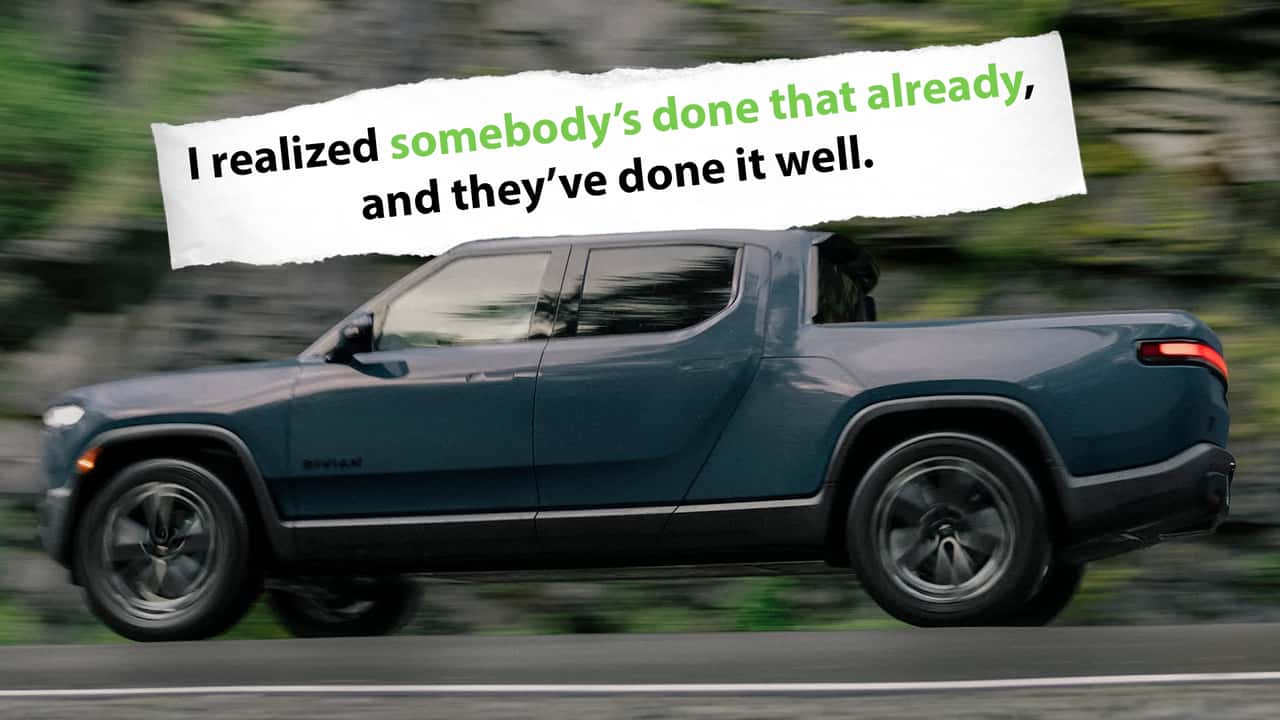- Rivian called Tesla “very inspirational” for its rise to become a leader in EVs
- It almost followed in Tesla’s footsteps in building a sports car before the R1
- CEO RJ Scaringe made a “very intentional” move to avoid copying Tesla’s “Master Plan”
It’s hard to ignore the contributions that Tesla made in the infancy of the modern EV industry. Many have given Tesla recognition for paving the way for electric cars in today’s market, and while some automakers have certainly used Tesla for inspiration in its own vehicles, others have purposefully steered their ship in a different direction to avoid copying Tesla’s homework.
Rivian is one of those companies.
Still a startup in itself, Rivian was founded in 2009—that’s just a year after Tesla CEO Elon Musk took the reins. Rivian founder and CEO RJ Scaringe has committed to doing things differently than Tesla. In a recent interview on Kleiner Perkin’s Grit Podcast, Scaringe explained he didn’t want Rivian to become just another Tesla, but instead find its own path forward in the emerging world of electric cars.

The best place to start here is the beginning when Elon Musk notoriously published his Master Plan back in 2006 (it’s still available on Tesla’s website, unlike its blog promising all of its EVs had hardware capable of achieving full self-driving). The plan outlined pumping out a low-volume sports car, followed by a moderate-volume sporty family sedan, and finally an affordable EV. Seems like a straightforward path—maybe even the best one—but Scaringe knew he couldn’t just mimic Tesla and achieve the same success:
“[A] logical place to start is build a sports car, use it to build the brand, then following the sports car, follow with more mass market vehicles, and that was, of course, how Tesla’s strategy played out, and it worked wonderfully well for them,” said Scaringe.
“We were starting in a similar logic space to say, ‘build a sports car,’ I realized somebody’s done that already, and they’ve done it well.”
It took Rivian nearly a decade to build its the first public concept that would eventually become the R1T. During that time, Scaringe and his team needed to figure out exactly how the company could differentiate itself from Tesla, or any other automaker looking to get into the EV space.
Rivian’s answer? Provide a branded experience rather than build just another commuter.
“[P]ivot to a completely different type of product,” said Scaringe, explaining that the company was aiming to provide a different “experience, vehicle topology, was a very intentional effort to also create a new story for not only us as a company or as a brand but, importantly, help shift mindsets around what sustainable transportation can look like.”
Rivian rolled the very first R1T off the production line in 2021 and the R1S SUV variant hit the road the following year.
Meanwhile, Rivian was also tapping into another space all while this was happening as well; one that Tesla hadn’t dared to touch yet. Following a $700 million influx of cash to Rivian in 2019, the automaker began to develop its commercial platform called the Electric Delivery Van. This allowed Rivian also to seize the opportunity to service the underdeveloped B2B market.
Scaringe’s approach to building cars shows just how the EV space still has opportunities for new and creative brands. That’s not to say manufacturing cars is easy—it very much isn’t. But it does prove that separating yourself from the pack is enough to get you noticed. The rest is a combination of the right ideas, an influx of cash, and willing consumers.
Rivian’s Decision Not To Copy Tesla’s Homework Was ‘Very Intentional’
In the rapidly evolving world of electric vehicle manufacturing, one company has made a bold decision that sets them apart from the crowd. Rivian, the American automaker specializing in electric trucks and SUVs, has deliberately chosen not to copy Tesla’s approach to innovation. This decision, according to Rivian’s CEO, was “very intentional.”
While Tesla has become synonymous with electric vehicles and has revolutionized the industry with their cutting-edge technology and innovative designs, Rivian has taken a different approach. Instead of following in Tesla’s footsteps, Rivian has chosen to forge a new path, focusing on their own unique vision and values.
This decision has not been without its challenges. In a market saturated with Tesla copycats and imitators, Rivian could have easily taken the easy route and replicated Tesla’s successful formula. However, the company’s leadership firmly believes that true innovation comes from thinking outside the box and charting their own course.
Rivian’s commitment to originality has been evident in their product lineup. Their electric trucks and SUVs boast distinctive designs, innovative features, and cutting-edge technology that set them apart from the competition. By refusing to copy Tesla’s homework, Rivian is able to create vehicles that stand out in a crowded marketplace and appeal to a different segment of consumers.
Furthermore, Rivian’s decision not to mimic Tesla’s approach has earned them respect within the industry. By demonstrating their commitment to innovation and originality, Rivian has proven themselves to be a formidable player in the electric vehicle market.
In conclusion, Rivian’s choice not to copy Tesla’s homework was a deliberate and strategic decision. By charting their own course and staying true to their vision, Rivian has set themselves apart from the competition and established themselves as a leader in the electric vehicle market. Only time will tell if this bold move will pay off, but for now, Rivian’s commitment to innovation and originality is setting them apart in a crowded field.

